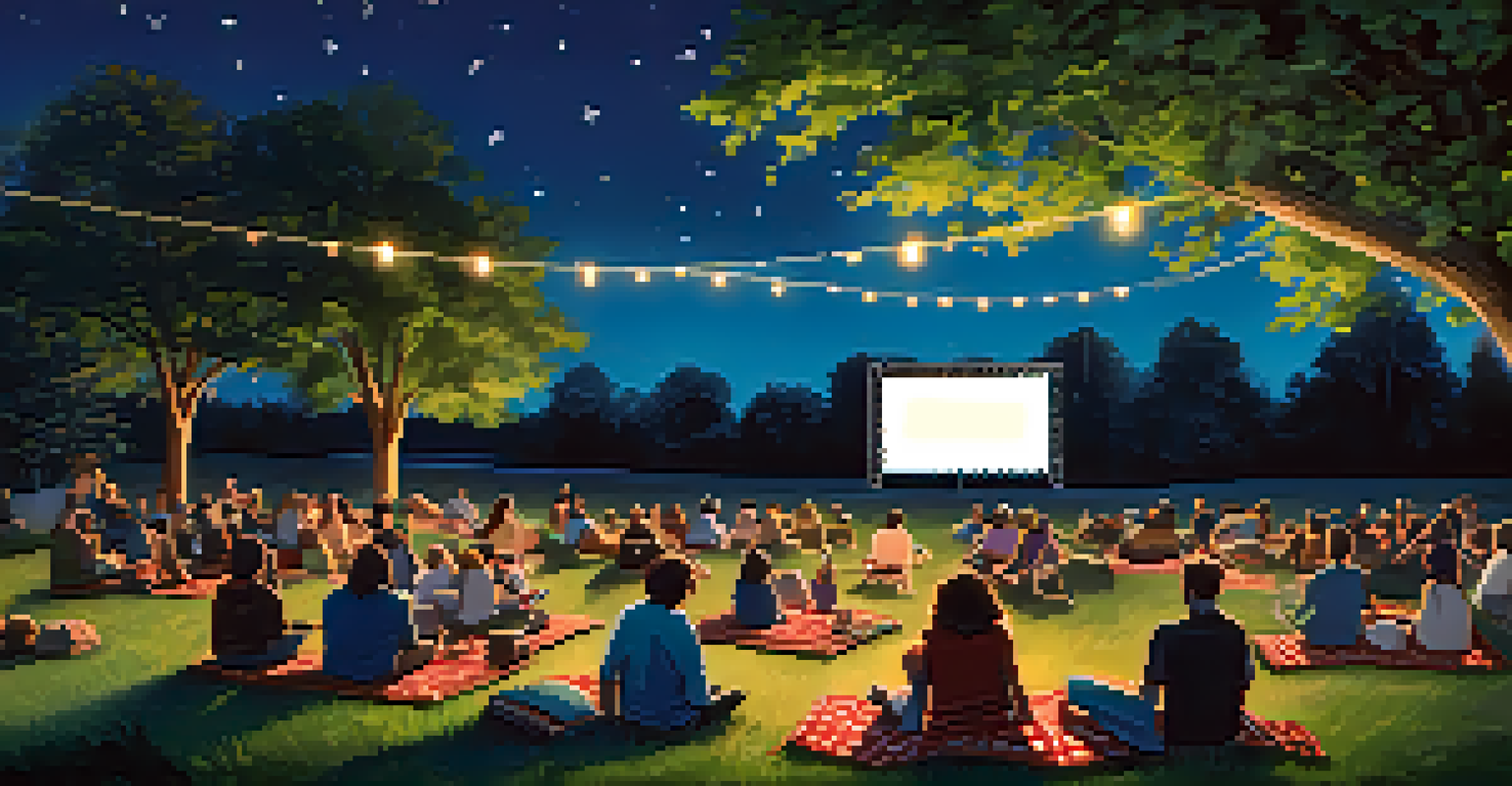The Evolution of Documentary Filmmaking in Hollywood Today

The Roots of Documentary Filmmaking in Hollywood
Documentary filmmaking has a rich history, dating back to the early 20th century when filmmakers like Robert Flaherty introduced audiences to real-life stories. His iconic work, 'Nanook of the North,' set a precedent for blending artistry with factual storytelling. This fusion of narrative and reality laid the groundwork for future filmmakers to explore diverse subjects in innovative ways.
Documentaries are the most powerful tool for social change we have.
As the decades progressed, documentaries evolved, reflecting societal changes and technological advancements. The advent of television in the 1950s brought documentary formats into homes, making them more accessible to the public. This shift not only broadened the audience but also influenced the types of stories being told, as filmmakers began to tackle pressing social issues.
By the late 20th century, documentaries gained a foothold in mainstream cinema, with filmmakers like Errol Morris and Michael Moore pushing boundaries. Their works challenged perceptions and sparked conversations, showing that documentaries could be both informative and provocative. This evolution set the stage for the vibrant documentary landscape we see today.
The Rise of Digital Technology in Documentaries
The digital revolution has significantly impacted documentary filmmaking, making it easier for filmmakers to produce high-quality content. With affordable cameras and editing software, a new generation of creators can tell their stories without the constraints of traditional filmmaking. This democratization of the medium has led to an explosion of diverse voices and perspectives.

Moreover, digital platforms like YouTube and Netflix have transformed how documentaries reach audiences. Filmmakers can now bypass traditional distribution channels, connecting directly with viewers worldwide. This shift not only increases accessibility but also encourages experimentation with formats and subjects, pushing the boundaries of what a documentary can be.
Documentaries Evolve with Technology
The rise of digital technology has democratized documentary filmmaking, enabling diverse voices to share their stories more easily.
For instance, platforms like Netflix have invested heavily in original documentary content, showcasing everything from true crime to environmental issues. These documentaries often blend entertainment with education, capturing viewer interest while sparking important conversations. As a result, the definition of a documentary continues to evolve, reflecting the changing landscape of media consumption.
The Impact of Streaming Services on Documentaries
Streaming services have revolutionized the documentary genre, offering unprecedented access to a wide array of films. Viewers no longer have to rely solely on traditional theaters or television schedules; they can watch documentaries at their convenience. This flexibility has significantly expanded the audience for documentaries, allowing niche subjects to find their dedicated viewers.
The truth is ever-changing and it’s up to us to keep up with it, to make films that reflect the complexity of our world.
Additionally, the algorithms used by streaming platforms help recommend documentaries tailored to individual tastes, further increasing engagement. As a result, audiences can discover lesser-known films that might have gone unnoticed in the past. This personalized viewing experience fosters a culture of exploration, inviting viewers to dive deeper into topics they may not have considered.
Moreover, the success of documentary series on platforms like Netflix has changed the game for storytelling. Instead of a single feature-length film, filmmakers can now explore complex topics over multiple episodes, allowing for more in-depth analysis. This format not only captivates audiences but also encourages binge-watching, leading to higher viewer retention.
The Role of Social Media in Documentary Filmmaking
Social media has become a powerful tool for documentary filmmakers, enabling them to engage with audiences in real-time. Platforms like Instagram and Twitter allow filmmakers to promote their work, share behind-the-scenes content, and foster community discussions. This direct interaction can build anticipation and create a loyal following even before a documentary is released.
Furthermore, social media serves as a platform for grassroots movements and advocacy, often highlighting the subjects of documentaries. For example, campaigns related to environmental issues or social justice can gain traction online, prompting filmmakers to address these topics in their work. This synergy between social media and documentary filmmaking amplifies important voices and stories.
Streaming Services Expand Reach
Streaming platforms have transformed how audiences access documentaries, allowing for greater flexibility and personalized viewing experiences.
Moreover, the use of social media can enhance storytelling, as filmmakers can share updates and insights during the production process. This transparency can create a sense of investment among viewers, making them feel like part of the journey. In this way, social media not only promotes documentaries but also enriches the overall narrative experience.
The Fusion of Documentary and Narrative Filmmaking
In recent years, there has been an intriguing blending of documentary and narrative filmmaking styles. Filmmakers are increasingly using documentary techniques, such as real interviews and archival footage, in narrative films to enhance authenticity. This hybrid approach creates a unique viewing experience that blurs the lines between fact and fiction.
For instance, films like 'The Act of Killing' and 'Waltz with Bashir' use narrative storytelling to explore real events, allowing viewers to connect emotionally with historical subjects. This fusion not only enriches the storytelling but also invites audiences to reflect on the complexities of truth and memory. Such innovative approaches have opened up new avenues for exploration in both genres.
Additionally, this blending resonates with audiences who crave authenticity in storytelling. In a world filled with curated social media personas and scripted reality shows, viewers are drawn to narratives that feel real and relatable. As a result, this trend may continue to grow, pushing filmmakers to experiment even further with their storytelling techniques.
The Influence of Global Perspectives on Documentaries
As the world becomes more interconnected, documentary filmmakers are increasingly drawing inspiration from global perspectives. This shift has led to a richer tapestry of stories that reflect diverse cultures, experiences, and issues. Filmmakers are now more attuned to the importance of representation, ensuring that underrepresented voices are heard.
For example, documentaries like '13th' and 'I Am Not Your Negro' examine race and identity through a global lens, inviting audiences to consider historical and contemporary injustices. By exploring these themes from multiple viewpoints, filmmakers can foster empathy and understanding among audiences worldwide. This global approach adds depth to the documentary genre, enriching the narratives being told.
Global Perspectives Enrich Narratives
Filmmakers are increasingly incorporating global perspectives, leading to a richer and more diverse tapestry of documentary storytelling.
Moreover, international collaborations are becoming more common, allowing filmmakers to share resources and expertise across borders. This collaboration not only enhances production quality but also encourages cross-cultural storytelling. As a result, documentaries are evolving into a platform for dialogue and connection, breaking down barriers and fostering a sense of shared humanity.
The Future of Documentary Filmmaking in Hollywood
The future of documentary filmmaking in Hollywood looks bright, with endless possibilities for innovation and creativity. As technology continues to advance, filmmakers will have even more tools at their disposal to tell compelling stories. From virtual reality experiences to interactive documentaries, the landscape is ripe for experimentation.
Additionally, as audiences become more socially conscious, there is a growing demand for documentaries that address pressing global issues. Filmmakers can seize this opportunity to not only entertain but also educate and inspire change. This shift toward socially relevant content can lead to documentaries that resonate deeply with viewers, making a lasting impact.

Ultimately, the evolution of documentary filmmaking is a testament to its enduring power. As filmmakers push boundaries and explore new storytelling techniques, the genre will continue to evolve, reflecting the world around us. This ongoing transformation promises to captivate audiences and shape the future of storytelling in profound ways.